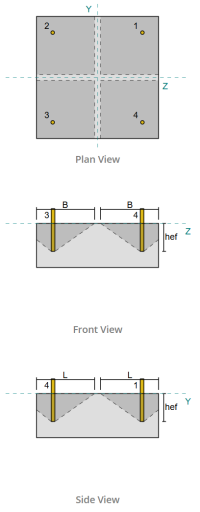Ontwerpvoorbeeld van basisplaat met CSA S16:19 en CSA A23.3:19
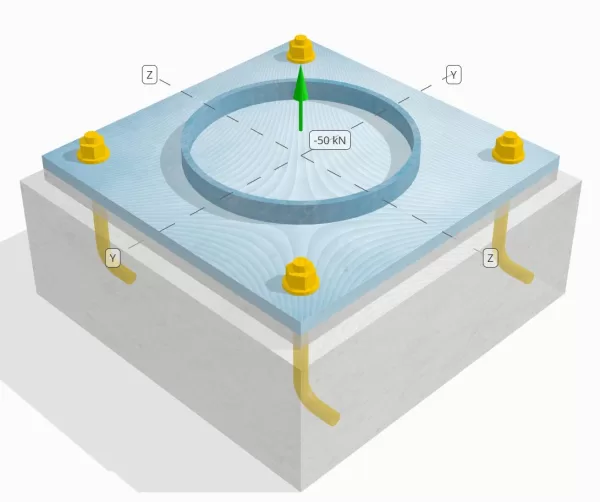
Probleemverklaring
Bepaal of de ontworpen kolom-naar-base plaataansluiting voldoende is voor een spanningsbelasting van 50 knap.
Gegeven gegevens
Kolom:
Kolomgedeelte: HS324X9.5
Kolomgebied: 9410 mm2
Kolommateriaal: 230G
Bodemplaat:
Baseplaat afmetingen: 500 mm x 500 mm
Basisplaatdikte: 20 mm
Basisplaatmateriaal: 230G
Vocht:
Vochtdikte: 20 mm
Beton:
Concrete dimensies: 550 mm x 550 mm
Betonnen dikte: 200 mm
Betonnen materiaal: 20.68 MPa
Gebarsten of ongescheurd: Gebarsten
Ankers:
Ankerdiameter: 19.1 mm
Effectieve inbeddingslengte: 130.0 mm
Hook length: 60mm
Anchor offset distance from face of column: 120.84 mm
Lassen:
Lastype: CJP
Vulmetaalclassificatie: E43XX
Ankergegevens (van Skyciv Calculator):
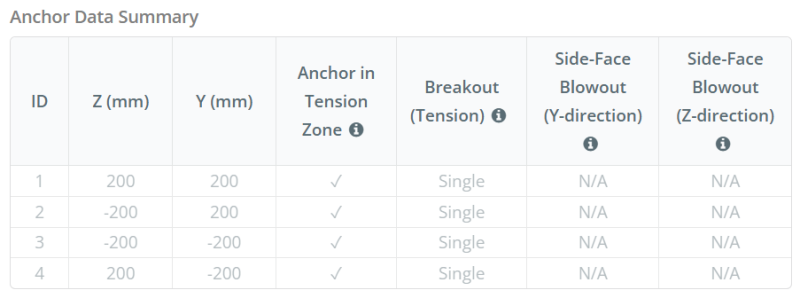
Model in SkyCiv Gratis tool
Modelleer vandaag nog het ontwerp van de basisplaat hierboven met onze gratis online tool! Geen aanmelding vereist.
Definities
Pad laden:
Wanneer een grondplaat wordt opgetild (treksterkte) krachten, deze krachten worden overgebracht op de ankerstangen, die op hun beurt buigmomenten in de basisplaat veroorzaken. De buigactie kan worden gevisualiseerd als cantilever buigen die zich voordoen rond de flenzen of het lijf van de kolomsectie, afhankelijk van waar de ankers zijn geplaatst.
In de SkyCiv-software voor het ontwerpen van grondplaten, Alleen ankers in de ankerspanningszone worden als effectief beschouwd bij het weerstaan van opheffing. Deze zone bevat meestal gebieden in de buurt van de kolomflenzen of het web. In the case of a circular column, the anchor tension zone includes the entire area outside the column perimeter. Ankers buiten deze zone dragen niet bij aan spanningsweerstand en zijn uitgesloten van de Uplift -berekeningen.
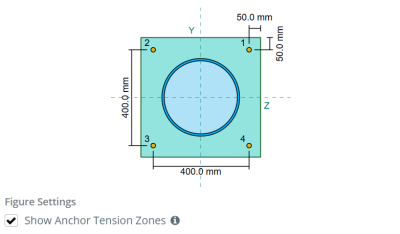
Om het effectieve gebied van de basisplaat te bepalen dat bestand is tegen buigen, een 45-graad spreiding wordt aangenomen vanaf de middellijn van elke ankerstaaf in de richting van het kolomvlak. Deze spreiding definieert de effectieve laslengte en helpt bij het opzetten van de effectieve buigbreedte van de plaat.
De veronderstelling vereenvoudigt de basisplaatanalyse door te benaderen hoe de opheffingskracht zich door de plaat verspreidt.
Ankergroepen:
De SkyCiv-software voor het ontwerpen van grondplaten Bevat een intuïtieve functie die identificeert welke ankers deel uitmaken van een ankergroep om te evalueren beton doorbraak en Concrete zij-gezichtsblaas mislukkingen.
Een ankergroep bestaat uit meerdere ankers met vergelijkbare effectieve inbeddingsdiepten en afstand, en zijn dichtbij genoeg dat hun geprojecteerde weerstandsgebieden overlappen elkaar. Wanneer ankers zijn gegroepeerd, Hun capaciteiten worden gecombineerd om de totale spanningskracht te weerstaan die op de groep wordt uitgeoefend.
Ankers die niet voldoen aan de groeperingscriteria worden behandeld als enkele ankers. In dit geval, Alleen de spanningskracht op het individuele anker wordt gecontroleerd tegen zijn eigen effectieve weerstandsgebied.
Stapsgewijze berekeningen
Controleren #1: Lascapaciteit berekenen
Beginnen, we need to calculate the load per anchor and determine the effective weld length for each anchor. De effectieve laslengte is based on a 45° dispersion line drawn from the center of the anchor to the face of the column. If this 45° line does not intersect the column, de tangent points are used instead. Bovendien, if the anchors are closely spaced, the effective weld length is reduced to avoid overlap. Uiteindelijk, the sum of all effective weld lengths must not exceed the actual weldable length available along the column circumference.
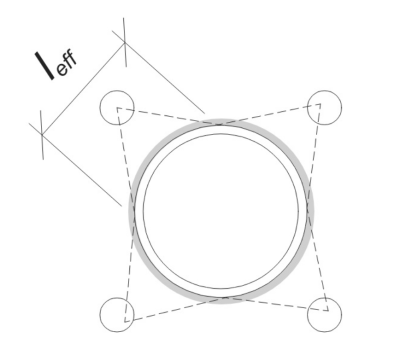
Let’s apply this to our example. Based on the given geometry, the 45° line from the anchor does not intersect the column. Als gevolg, the arc length between the tangent points is used instead. This arc length must also account for any adjacent anchors, with any overlapping portions subtracted to avoid double-counting. The calculated arc length is:
\(
l_{\tekst{boog}} = 254.47 \, \tekst{mm}
\)
This arc length calculation is fully automated in the SkyCiv Base Plate Design Software, but it can also be performed manually using trigonometric methods. You can try the free tool from this link.
Considering the available weldable length along the column’s circumference, the final effectieve laslengte is:
\(
l_{\tekst{eff}} = min links( l_{\tekst{boog}}, \frac{\pi d_{\tekst{col}}}{N_{een,t}} \Rechtsaf) = min links( 254.47 \, \tekst{mm}, \frac{\pi \times 324 \, \tekst{mm}}{4} \Rechtsaf) = 254.47 \, \tekst{mm}
\)
De volgende, Laten we de belasting per anker. Voor een gegeven set van vier (4) ankers, de belasting per anker is:
\(
T_{u,\tekst{anker}} = frac{N_x}{N_{een,t}} = frac{50 \, \tekst{kN}}{4} = 12.5 \, \tekst{kN}
\)
Met behulp van de berekende effectieve laslengte, we can now compute the required force per unit length acting on the weld.
\(
v_f = \frac{T_{u,\tekst{anker}}}{l_{\tekst{eff}}} = frac{12.5 \, \tekst{kN}}{254.47 \, \tekst{mm}} = 0.049122 \, \tekst{kN / mm}
\)
Nu, wij verwijzen naar CSA S16:19 Clausule 13.13.3.1 om de factored resistance of the complete joint penetration (CJP) lassen. This requires the base metal resistance, expressed in force per unit length, for both the column and the base plate materials.
\(
v_{r,\tekst{bm}} = phi links( \min links( F_{j,\tekst{col}} t_{\tekst{col}}, F_{j,\tekst{bp}} t_{\tekst{bp}} \Rechtsaf) \Rechtsaf)
\)
\(
v_{r,\tekst{bm}} = 0.9 \keer links( \min links( 230 \, \tekst{MPa} \keer 9.53 \, \tekst{mm}, 230 \, \tekst{MPa} \keer 20 \, \tekst{mm} \Rechtsaf) \Rechtsaf) = 1.9727 \, \tekst{kN / mm}
\)
Sinds 0.049122 kN / mm < 1.9727 kN / mm, De lascapaciteit is voldoende.
Controleren #2: Bereken de buigcapaciteit van de basisplaat als gevolg van spanningsbelasting
Using the load per anchor and the offset distance from the center of the anchor to the face of the column, het moment dat op de basisplaat wordt uitgeoefend, kan worden berekend met behulp van a cantilever aanname. For a circular column, the load eccentricity is determined by considering the sagitta of the welded arc, and can be calculated as follows:
\(
e_{\tekst{pipe}} = d_o + R_{\tekst{col}} \links( 1 – \cos links( \frac{l_{\tekst{eff}}}{2 R_{\tekst{col}}} \Rechtsaf) \Rechtsaf)
\)
\(
e_{\tekst{pipe}} = 120.84 \, \tekst{mm} + 162 \, \tekst{mm} \keer links( 1 – \cos links( \frac{254.47 \, \tekst{mm}}{2 \keer 162 \, \tekst{mm}} \Rechtsaf) \Rechtsaf) = 168.29 \, \tekst{mm}
\)
The induced moment is computed as:
\(
M_f = T_{u,\tekst{anker}} e_{\tekst{pipe}} = 12.5 \, \tekst{kN} \keer 168.29 \, \tekst{mm} = 2103.6 \, \tekst{kN} \cdot tekst{mm}
\)
De volgende, we will determine the bending width of the base plate. Voor deze, we use the chord length corresponding to the effective weld arc.
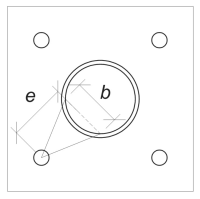
\(
\theta_{\tekst{rad}} = frac{l_{\tekst{eff}}}{0.5 d_{\tekst{col}}} = frac{254.47 \, \tekst{mm}}{0.5 \keer 324 \, \tekst{mm}} = 1.5708
\)
\(
b = d_{\tekst{col}} \links( \zonde links( \frac{\theta_{\tekst{rad}}}{2} \Rechtsaf) \Rechtsaf) = 324 \, \tekst{mm} \keer links( \zonde links( \frac{1.5708}{2} \Rechtsaf) \Rechtsaf) = 229.1 \, \tekst{mm}
\)
Uiteindelijk, we kunnen de berekenen meegerekend flexural resistance van de basisplaat gebruiken CSA S16:19 Clausule 13.5.
\(
M_r = \phi F_{j,\tekst{bp}} Z_{\tekst{eff}} = 0.9 \keer 230 \, \tekst{MPa} \keer 22910 \, \tekst{mm}^3 = 4742.4 \, \tekst{kN} \cdot tekst{mm}
\)
Waarbij,
\(
Z_{\tekst{eff}} = frac{b (t_{\tekst{bp}})^ 2}{4} = frac{229.1 \, \tekst{mm} \keer (20 \, \tekst{mm})^ 2}{4} = 22910 \, \tekst{mm}^3
\)
Sinds 2103.6 kN-mm < 4742.4 kN-mm, De buigplaten van de basisplaat is voldoende.
Controleren #3: Bereken de trekcapaciteit van de ankerstaaf
Om het trekvermogen van de ankerstang te evalueren, we refer to CSA A23.3:19 Clause D.6.1.2 and CSA S16:19 Clausule 25.3.2.1.
Eerste, We bepalen de gespecificeerde treksterkte van het ankerstaal. Dit is de laagste toegestane waarde CSA A23.3:19 Clause D.6.1.2.
\(
f_{\tekst{uta}} = min links( F_{u,\tekst{anc}}, 1.9 F_{j,\tekst{anc}}, 860 \Rechtsaf) = min links( 400 \, \tekst{MPa}, 1.9 \keer 248.2 \, \tekst{MPa}, 860.00 \, \tekst{MPa} \Rechtsaf) = 400 \, \tekst{MPa}
\)
De volgende, We bepalen de effectief dwarsdoorsnedeoppervlak of the anchor rod in tension using CAC Concrete Design Handbook, 3RD -editie, Tafel 12.3.
\(
EEN_{ik weet,N} = 215 \, \tekst{mm}^ 2
\)
Met deze waarden, We passen toe CSA A23.3:19 Eq. D.2 om de te berekenen factored tensile resistance van de ankerstang.
\(
N_{\tekst{sar}} = A_{ik weet,N} \phi_s f_{\tekst{uta}} R = 215 \, \tekst{mm}^2 tijden 0.85 \keer 400 \, \tekst{MPa} \keer 0.8 = 58.465 \, \tekst{kN}
\)
Bovendien, We evalueren de factored tensile resistance according to CSA S16:19 Clausule 25.3.2.1.
\(
T_r = \phi_{ar} 0.85 EEN_{ar} F_{u,\tekst{anc}} = 0.67 \keer 0.85 \keer 285.02 \, \tekst{mm}^2 tijden 400 \, \tekst{MPa} = 64.912 \, \tekst{kN}
\)
After comparing the two, we identify that the factored resistance calculated using CSA A23.3:19 governs in this case.
Bedenk de eerder berekende spanningsbelasting per anker:
\(
N_{fa} = frac{N_x}{N_{een,t}} = frac{50 \, \tekst{kN}}{4} = 12.5 \, \tekst{kN}
\)
Sinds 12.5 kN < 58.465 kN, De trekcapaciteit van de ankerkam is voldoende.
Controleren #4: Bereken de betonuitbraakcapaciteit in spanning

Voordat u de breakout -capaciteit berekent, We moeten eerst bepalen of het lid in aanmerking komt als een smal lid. Volgens CSA A23.3:19 Clause D.6.2.3, the member does not meet the criteria for a narrow member. Daarom, the given Effectieve inbeddingslengte will be used in the calculations.
Gebruik makend van CSA A23.3:19 Eq. D.5, we berekenen de maximaal geprojecteerd betonkegeloppervlak voor één enkel anker, based on the effective embedment length.
\(
EEN_{Onthouden} = 9 (h_{ef,s1})➔⡔ Koop generieke tadalafil 9 \keer (130 \, \tekst{mm})➔⡔ Koop generieke tadalafil 152100 \, \tekst{mm}^ 2
\)
Evenzo, we use the effective embedment length to calculate the Werkelijk geprojecteerd betonnen kegelgebied of the single anchor.
\(
EEN_{Nc} = L_{Nc} B_{Nc} = 270 \, \tekst{mm} \keer 270 \, \tekst{mm} = 72900 \, \tekst{mm}^ 2
\)
Waarbij,
\(
L_{Nc} = links( \min links( c_{\tekst{links},s1}, 1.5 h_{ef,s1} \Rechtsaf) \Rechtsaf) + \links( \min links( c_{\tekst{Rechtsaf},s1}, 1.5 h_{ef,s1} \Rechtsaf) \Rechtsaf)
\)
\(
L_{Nc} = links( \min links( 475 \, \tekst{mm}, 1.5 \keer 130 \, \tekst{mm} \Rechtsaf) \Rechtsaf) + \links( \min links( 75 \, \tekst{mm}, 1.5 \keer 130 \, \tekst{mm} \Rechtsaf) \Rechtsaf)
\)
\(
L_{Nc} = 270 \, \tekst{mm}
\)
\(
B_{Nc} = links( \min links( c_{\tekst{top},s1}, 1.5 h_{ef,s1} \Rechtsaf) \Rechtsaf) + \links( \min links( c_{\tekst{bodem},s1}, 1.5 h_{ef,s1} \Rechtsaf) \Rechtsaf)
\)
\(
B_{Nc} = links( \min links( 75 \, \tekst{mm}, 1.5 \keer 130 \, \tekst{mm} \Rechtsaf) \Rechtsaf) + \links( \min links( 475 \, \tekst{mm}, 1.5 \keer 130 \, \tekst{mm} \Rechtsaf) \Rechtsaf)
\)
\(
B_{Nc} = 270 \, \tekst{mm}
\)
De volgende, We evalueren de meegerekend basic concrete breakout resistance van een enkel anker met behulp van CSA A23.3:19 Eq. D.6
\(
N_{br} = k_c \phi \lambda_a \sqrt{\frac{f'_c}{\tekst{MPa}}} \links( \frac{h_{ef,s1}}{\tekst{mm}} \Rechtsaf)^{1.5} R N
\)
\(
N_{br} = 10 \keer 0.65 \keer 1 \keer sqrt{\frac{20.68 \, \tekst{MPa}}{1 \, \tekst{MPa}}} \keer links( \frac{130 \, \tekst{mm}}{1 \, \tekst{mm}} \Rechtsaf)^{1.5} \keer 1 \keer 0.001 \, \tekst{kN} = 43.813 \, \tekst{kN}
\)
Waarbij,
- \(zodat ingenieurs precies kunnen nagaan hoe deze berekeningen zijn gemaakt{c} = 10\) voor ingestorte ankers
- \(\lambda = 1.0 \) voor normaal gewicht beton
Nu, we beoordelen de effecten van geometrie door de randeffectfactor.
De kortste randafstand van de ankergroep wordt bepaald als:
\(
c_{een,\tekst{min}} = min links( c_{\tekst{links},s1}, c_{\tekst{Rechtsaf},s1}, c_{\tekst{top},s1}, c_{\tekst{bodem},s1} \Rechtsaf) = min links( 475 \, \tekst{mm}, 75 \, \tekst{mm}, 75 \, \tekst{mm}, 475 \, \tekst{mm} \Rechtsaf) = 75 \, \tekst{mm}
\)
Volgens CSA A23.3:19 Eq. D.10 and D.11, de uitbraak randeffectfactor is:
\(
\Psi_{ed,N} = min links( 1.0, 0.7 + 0.3 \links( \frac{c_{een,\tekst{min}}}{1.5 h_{ef,s1}} \Rechtsaf) \Rechtsaf) = min links( 1, 0.7 + 0.3 \keer links( \frac{75 \, \tekst{mm}}{1.5 \keer 130 \, \tekst{mm}} \Rechtsaf) \Rechtsaf) = 0.81538
\)
Daarnaast, Beide kraakfactor als de splitsingsfactor worden genomen als:
\(
\Psi_{c,N} = 1
\)
\(
\Psi_{cp,N} = 1
\)
Vervolgens, we combineren al deze factoren en gebruiken ACI 318-19 Eq. 17.6.2.1b om de meegerekend concrete breakout resistance of the single anchor:
\(
N_{cbr} = links( \frac{EEN_{Nc}}{EEN_{Onthouden}} \Rechtsaf) \Psi_{ed,N} \Psi_{c,N} \Psi_{cp,N} N_{br} = links( \frac{72900 \, \tekst{mm}^ 2}{152100 \, \tekst{mm}^ 2} \Rechtsaf) \keer 0.81538 \keer 1 \keer 1 \keer 43.813 \, \tekst{kN} = 17.122 \, \tekst{kN}
\)
Bedenk de eerder berekende spanningsbelasting per anker:
\(
N_{fa} = frac{N_x}{N_{een,s}} = frac{50 \, \tekst{kN}}{4} = 12.5 \, \tekst{kN}
\)
Sinds 12.5 kN < 17.122 kN De betonnen breakout -capaciteit is voldoende.
This concrete breakout calculation is based on Anchor ID #1. The same capacity will apply to the other anchors due to the symmetric design.
Controleren #5: Bereken het pull -outcapaciteit van het anker
Het uittrekvermogen van een anker wordt bepaald door de weerstand aan het ingebedde uiteinde ervan. For hooked anchors, it is dependent on its hook length.
We compute the factored basic anchor pullout resistance per CSA A23.3:19 Eq. D.17.
\(
N_{pr} = \Psi_{c,p} 0.9 \phi (f'_c) e_h d_a R = 1 \keer 0.9 \keer 0.65 \keer (20.68 \, \tekst{MPa}) \keer 60 \, \tekst{mm} \keer 19.05 \, \tekst{mm} \keer 1 = 13.828 \, \tekst{kN}
\)
Bedenk de eerder berekende spanningsbelasting per anker:
\(
N_{fa} = frac{N_x}{N_{een,t}} = frac{50 \, \tekst{kN}}{4} = 12.5 \, \tekst{kN}
\)
Sinds 12.5 kN < 13.828 kN, De pull -outcapaciteit van het anker is voldoende.
Controleren #6: Bereken de side-face blowoutcapaciteit in Y-richting
This calculation is not applicable for hooked anchors.
Controleren #7: Bereken side-face blowoutcapaciteit in Z-richting
This calculation is not applicable for hooked anchors.
Ontwerp Samenvatting
De Skyciv Base Plate Design Software Kan automatisch een stapsgewijze berekeningsrapport genereren voor dit ontwerpvoorbeeld. Het biedt ook een samenvatting van de uitgevoerde controles en hun resulterende verhoudingen, De informatie in één oogopslag gemakkelijk te begrijpen maken. Hieronder is een sample samenvattende tabel, die is opgenomen in het rapport.
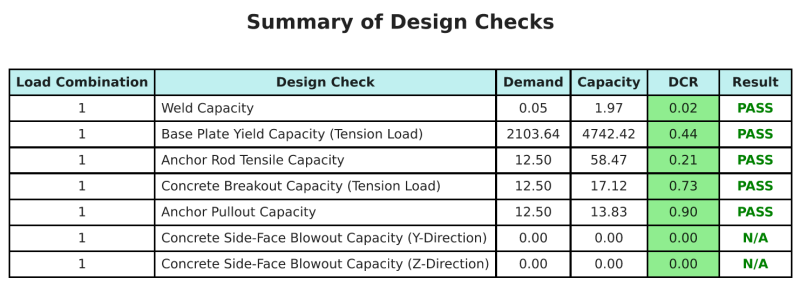
Skyciv Sample Report
Bekijk het detailniveau en de duidelijkheid die u kunt verwachten van een SkyCiv-basisplaatontwerprapport. Het rapport bevat alle belangrijke ontwerpcontroles, vergelijkingen, en resultaten gepresenteerd in een duidelijk en gemakkelijk leesbaar formaat. Het voldoet volledig aan de ontwerpnormen. Klik hieronder om een voorbeeldrapport te bekijken dat is gegenereerd met de SkyCiv-basisplaatcalculator.
Koop baseplaatsoftware
Purchase the full version of the base plate design module onits own without any other SkyCiv modules. Dit geeft u een volledige set resultaten voor het ontwerp van de basisplaat, inclusief gedetailleerde rapporten en meer functionaliteit.

